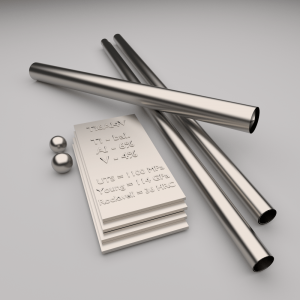An alloy is a mixture of two or more materials, at least one of which is a metal. Alloys can have a microstructure consisting of solid solutions, where secondary atoms are introduced as substitutionals or interstitials in a crystal lattice. An alloy may also be a mixture of metallic phases (two or more solutions, forming a microstructure of different crystals within the metal). Examples of substitutional alloys include bronze and brass, in which some of the copper atoms are substituted with either tin or zinc atoms respectively.
An interstitial alloys are a compound that is formed when an atom with a small enough radius sits in an interstitial “hole” in a metal lattice. Examples of small atoms are hydrogen, boron, carbon and nitrogen.
Solid solutions have important commercial and industrial applications, as such mixtures often have superior properties to pure materials. Many metal alloys are solid solutions. Even small amounts of solute can affect the electrical and physical properties of the solvent. Alloys are usually stronger than pure metals, although they generally offer reduced electrical and thermal conductivity. Strength is the most important criterion by which many structural materials are judged. Therefore, alloys are used for engineering construction.
 Non-ferrous alloys those that does not contain iron (ferrite) in appreciable amounts thus they are based on non-ferrous metals (i.e. aluminium, gold, nickel, silver, tin, lead, zinc, etc.) Other common properties of non-ferrous metals are non-magnetic, malleable, and lightweight. Alloy systems are classified either according to the base metal or according to some specific characteristic that a group of alloys share.
Non-ferrous alloys those that does not contain iron (ferrite) in appreciable amounts thus they are based on non-ferrous metals (i.e. aluminium, gold, nickel, silver, tin, lead, zinc, etc.) Other common properties of non-ferrous metals are non-magnetic, malleable, and lightweight. Alloy systems are classified either according to the base metal or according to some specific characteristic that a group of alloys share.
Also non-ferrous alloys can be heat treated to alter the properties of strength, ductility, toughness, hardness or resistance to corrosion. There is a number of phenomena that occur in metals and alloys at elevated temperatures. For example, recrystallization and the precipitation. These are effective in altering the mechanical characteristics when appropriate heat treatments or thermal processes are used. In fact, the use of heat treatments on commercial alloys is an exceedingly common practice. Common heat treatment processes include annealing, precipitation hardening, and even quanching and tempering. For example, quenching is a process of cooling a metal at a rapid rate. This is most often done to produce a martensite transformation. In ferrous alloys, this will often produce a harder metal, while non-ferrous alloys will usually become softer than normal.
Types of Non-ferrous Alloys
As was written, alloy systems are classified either according to the base metal or according to some specific characteristic that a group of alloys share.
- Aluminium Alloys
- Copper Alloys
- Magnesium Alloys
- Titanium Alloys
- Nickel Alloys
- Lead Alloys
- Tin Alloys
- Zinc Alloys
- Zirconium Alloys
Another method is to group alloys by key application properties, such as density, corrosion resistance, melting point, and so on.
- Light metals (aluminium, magnesium, and titanium)
- Corrosion-resistance alloys (cobalt, copper, nickel, titanium, aluminium)
- Superalloys (nickel, cobalt, iron-nickel)
- Refractory metals (molybdenum, niobium, tantalum, and tungsten)
- Low-melting-point metals (tin, bismuth, indium, lead, zinc)
- Reactive metals (titanium, and zirconium)
- Precious metals (gold, silver, platinum, palladium, iridium, rhodium, ruthenium, and osmium)
We hope, this article, Non-ferrous Alloys, helps you. If so, give us a like in the sidebar. Main purpose of this website is to help the public to learn some interesting and important information about materials and their properties.